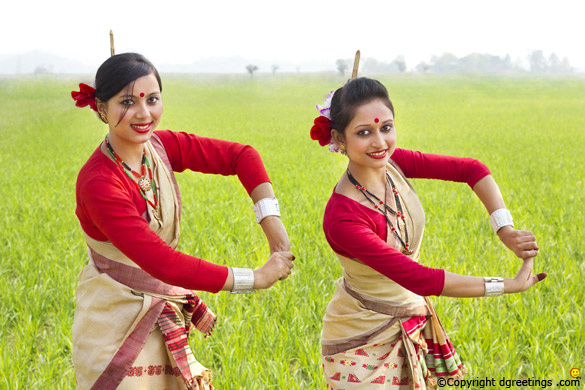Bihu Festival Assam-types, celebration
Table of Contents
Why is Assam Famous?
Assam is famous for its teas estates, sericulture industry, wild life sanctuaries – the habitats of rapidly disappearing one horned rhinoceros and hornbills.
But the very first picture that comes in our mind with Assam is of young men and women, adorned in traditional attire, performing Bihu folk dance on the joyful beats of music.
Assam is synonymous to Bihu, that marks the beginning on New year as per Assamese calendar.
“Bihu is as old as the river Brahmaputra”. A lifeline for Assamese People!
3 Types of Bihu celebrations
-
Rongali or Bohag Bihu
The word Rongali suggests in itself the emotion of joyfulness. Rongali or Bohag Bihu is celebrated during the month of April, on the occasion of the Assamese New Year. New year begins with new life everywhere as the dry weather of February and March (Fagun and Choit) reaches to its climax. New leaves and beautiful flowers of Nahor, Togor can be sighted in the gardens.
-
Magh Bihu or Bhogali Bihu
Magh or Bhogali Bihu is the festival of feast, celebrated in the Assamese month of Magh (mid-January) and marks the harvesting of the crops, when the farmers finally get a window of rest after a prolonged period of hard labour in the fields and when there is surplus food. The idea is to thank the gods for the blessing of a good harvest, especially rice. During the two days of the festival, people of a particular Chuk-Chuburi or khel or the village gather to have a feast together.
-
Kati Bihu or Kongali Bihu
The word ‘kongal’ means ‘scarcity’ as this festival falls during the days of scarcity, when the paddies in the field are half-grown and there are very few reserves in the granaries. This Bihu is observed during the Assamese moth of Kati (mid-October). Since there is scarcity all around, the festival doesn’t allow much celebration. However, some important rituals and rites are observed to ward off evil from the crops and the community on the evening of the day of Kati Bihu.
What is so special about Bihu dance?
Bihu dance is the most unique element of the Bohag Bihu celebration. Bihu dance, in nutshell, an expression of joy, love and happiness. People belonging to various age groups—both old and young—get together to sway to the rhythm of the dhol, pepa and gogona.
3 Main forms of Bihu dance
- Lora Nas (dance of the male dancers): Young boys dance on the tunes of pepa(horn), gogona and banhi (flute), dhol in a circular motion comprised of simple steps and peculiar waist movements.
- Suwali Nas (dance by the girls): Once the boys complete their dance, the girls come forward singing traditional songs. Traditional music instruments – gogona is played by the girls themselves, the pepa is played by a musician known as pepuwa.
- Burha Naas: This is a special segment of Bihu dance which is dedicated to the old performers who can’t dance fast due to their age. The rhythms are very slow compared to others.
Traditional dresses for Bihu festival
Bihu Dress for Young girls
Young girls beautifully adorned in Mekhela Chador. This traditional dress is made of muga silk assesorised with kapou ful(orchids) in their hairs.
They use Gam kharu which is also called Muthi kharu on their wrists. It is a kind of bangle actually.
They tie their waist with ‘hasoti’ which is like a small towel and also a riha(a piece of cloth) under the chador. To add colour to their lips, they used the colour from a small tree called Barhamthuri.
Bihu Dress for Boys
The costumes of boys include a dhoti, a chapkan chola, baniyan or a kurta-like shirt. On the neck and on the head they use gamocha. On the waist they wear the tongali (a piece of red cloth like the gamocha). On their both hands boys wear romal or hasoti (a small piece of cloth). and wear ornaments like Jhangfai and Lokapar. But with time the traditions has been rectified with a tinge of modernity.
Also Read: What happens in the 7 days of Rongali or Bohag Bihu celebrations?




